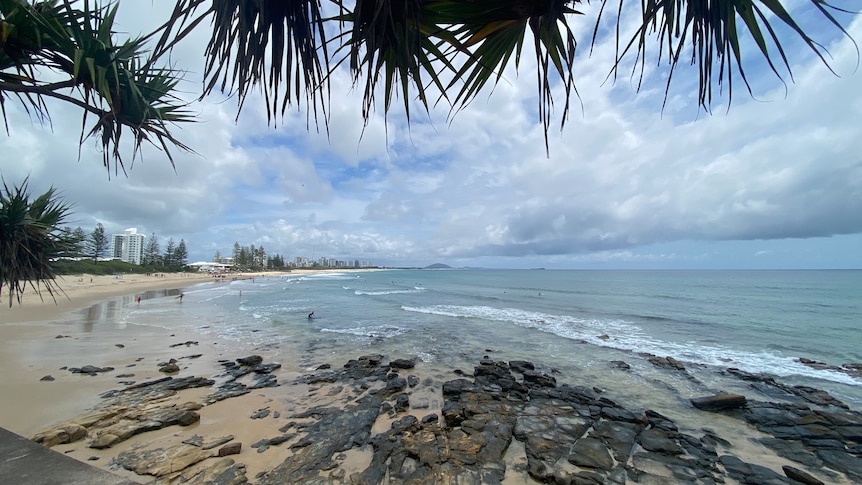Australia Weather News

Weak, choppy waves have forced some diehards to fly interstate to get their fix. (ABC Sunshine Coast: Kirra Grimes)
Surfers Paradise has become anything but, with famed surf breaks across south-east Queensland falling short of expectation, frustrating boardriders and coastal communities.
Weak, choppy waves have been a constant for the past month, even forcing some diehards to fly to interstate surf parks to get their fix.
While conditions are forecast to improve in the coming week, the impact of fewer beach breaks has already come at a cost.
Why the lack of swell?
Sunshine Coast surf forecaster Anthony 'Spinksy' Spinks said a high-pressure system in the Tasman and Coral seas was blocking the systems that would normally produce bigger swell.
While this was not unusual for the spring months, he said recent conditions were the worst he had seen in four years.
"It's been quite dismal," he said.
"This small surf that we have had has just pretty much been lapping at the shoreline.
"For most [experienced surfers] like myself and others, these tiny waves — we just don't even bother looking at them."
On the Gold Coast, surf reporter Terry "Tappa" Teece said conditions were worse than this time last year.
"We're just getting short period wind swells from the northerly winds that have been blowing up," he said.
"So, yeah, there hasn't been many waves around at all."
Surfing 'drought' taking a toll
Alexandra Headland cafe owner Steve Arthy said some of his regulars were now rarely spotted.
He said those who continued having a post-surf coffee — minus the surf — had a noticeable change in demeanour.
"It's like a real deflation in their mood, like a slight depression over the community," Mr Arthy said.
"I understand being a surfer, there's a lot of benefits both physically and mentally from surfing.
"And, yeah, when there's no waves, it does have an effect."
Ocean economist and geographer Javier Leon said the poor surf was sure to have an economic impact as well.
Pre-COVID studies by the University of the Sunshine Coast found surfers typically injected $8 a day or $1,500 a year into the local economy through spending on food, parking, surfboards, wetsuits and other accessories.
"Surfing is quite a significant economic activity within tourism," Dr Leon said.
"Places like Noosa, for example, can go from crowds of 40 people on average to up to 300 on average when we do have waves.
"So that's quite a big jump, and that's quite a lot of more direct expenditure on the place."
Surfers leaving town for good breaks
Mr Teece said those unable to wait for the return of decent swell may turn to artificial wave parks — the closest being in Sydney and Melbourne.
"I know I've got mates who've flown [interstate] down for a couple of days' trip. I've done it myself."
Noosa surfboard shaper Tully St John said he had noticed a "lull" and would not be surprised if local surfers had skipped town in search of better waves.
"Surfers will go to the end of the world to get a wave and, you know, feel that enjoyment," he said.
Surf tour guide Seb Higgins-George said everyone felt it when the surf went flat, even if they were not boardriders themselves.
"When the swell's up, there's definitely a buzz in the air," he said.
"People are getting up a lot earlier and getting down to the beach even just to have a look. We haven't seen that for quite a while.
"It's been a bit of a slog this year."
Small swells benefits beaches, beginners
Dr Leon said one benefit of subdued swells was the improved health of coastal ecosystems.
He said sand dunes had been able to recover significantly from erosion over the past year after back-to-back La Niña events.
"Most beaches have recovered and been as wide as they get, and the dunes are starting to grow," Dr Leon said.
"That's really good news — just ready for the high-energy season in summer."
North Caloundra Surf School instructor Russell Hoffman said beginner surfers had been enjoying the small waves.
He said for more advanced surfers itching to get back out, the best bets were sheltered south-facing beaches.
"If you want to surf a few days a week, every week, then you're going to be a bit let down [this time of year]," Mr Hoffman said.
"If someone's just looking for a wave, shop around.
"Try and get out there early before it gets too crowded as well because when it's choppy, there's usually only a few protected spots along the coast."
ABC